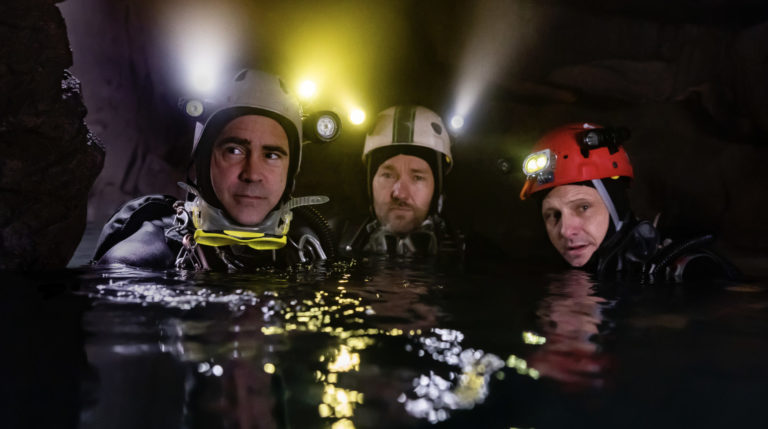
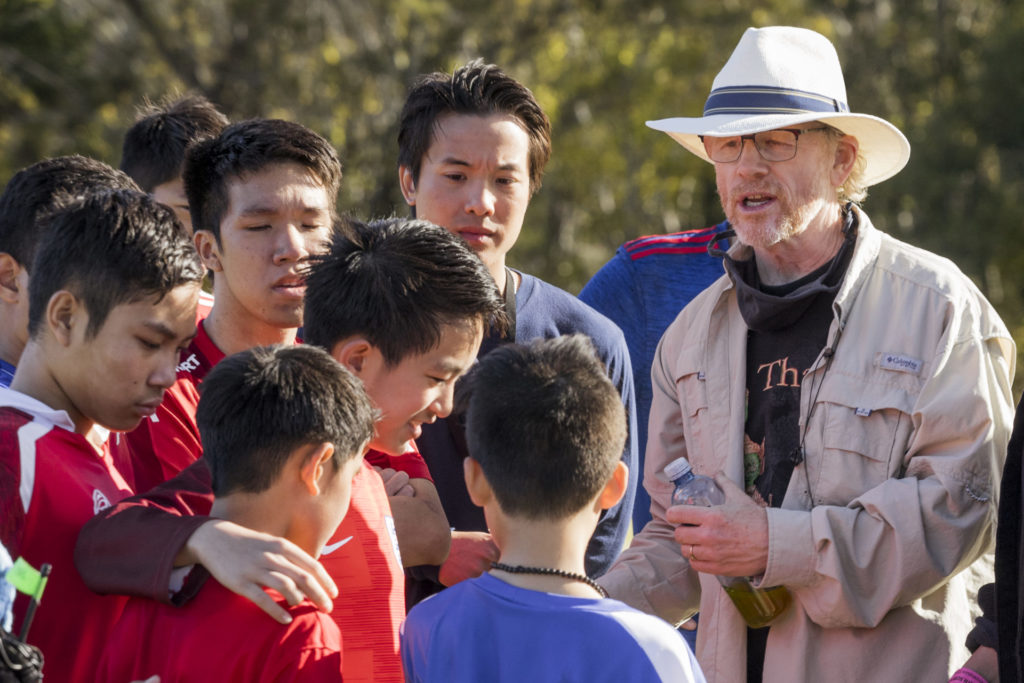
Press Conference with director Ron Howard, co-producer Raymond Phathanavirangoon, Actors Joel Edgerton, Tom Bateman, James Teeradon, Pattakorn Tungupakul, Poo Sahajak, Weir Sukollowat, Viggo Mortensen and a real life diver Rick Stanton and the real-life water engineer Thanet Natisri.
Q: Ron, with so many players and stories, what were the essential elements you sought to capture in this telling of this story?
Ron: It was almost entirely built around the key turning points, the critical challenges and the way that they were met. There’s a scene in “Apollo 13” that people reference and it shows up on clips to this day. It’s where they throw all of this junk on the table and they say this is what they have for us to fix their oxygen system. This is all they have onboard to work with, we’re going to have to figure it out. And they do. It’s based on a real event.
But when I read this script, there were many surprises in terms of the wide variety of heroic selfless acts that were demonstrated that I didn’t know about, in addition to the heroism and remarkable feats that the divers achieved. There was this sort of seat-of-your-pants problem-solving going on while under duress and pressure. I was fascinated by that. I tried to lay out what the technical problems were, what were the emotional challenges, and where the physical threats were. We just kept building scenes around that.
With a scripted dramatized version of an event like this, you have to have great actors and scenes you can construct to make these points. There’s that larger theme that you are talking about. But it’s also the price that people pay, the investment that they make, that you don’t see in a headline. If you’re an audience member, it makes the film very relatable, creates empathy, and suspense. It just reminds us what the real heroes did for us, it creates an object lesson in what is possible.
But of course, they are people — people making decisions. And in this case, a lot of courageous people and volunteers. It’s one thing to see highly trained individuals doing the thing they’re paid to do. Rick Stanton was a firefighter. A story about him on the job going and doing a rescue is one thing. It’s another thing when Rick Stanton is an expert cave diver. This is his hobby and he agrees to take this period of time in his life, putting himself at risk physically, emotionally, and everything else as an act of volunteerism.
It wasn’t just the divers’ volunteering, it was thousands, including Thanet, whose remarkable efforts were made there. I was just fascinated by the tapestry of volunteerism, intercultural interaction, and courage.
Q: Speaking about the intercultural nature of it, there wasn’t any English spoken for more than maybe 15, 20 minutes.
Ron: Probably eight minutes.
Q: Why did you make that decision — to minimize the English?
Ron: Audiences are more and more sophisticated all the time thanks in a large part to [the evolution of] streaming. I’ve seen it my entire career. Audiences are becoming more discerning, they’re smarter. This is an expectation now. I don’t think people want things to be homogenized and simplified. In fact with a story like this, they want what’s granular and for it to feel authentic and true.
I never blinked about that. Fortunately, the studio executives were very, very supportive. It was a screenwriter writing a script in English. It’s a director who doesn’t speak Thai. That’s where somebody like Raymond who was one of our producers, and who’s also a writer. He could come in and work with this translation and help me deputize the cast and not make mistakes here. You’re professionals and doing your job, but part of your job here is to make this play as if it was a Thai movie.
The scenes and details are vitally important to me in that way. Everyone rose to the occasion and brought a lot of detail, not just changing the dialogue, but ideas for moments within the scenes and with the attitudes that just enriched them. All of us foreigners working on the film really appreciated it.
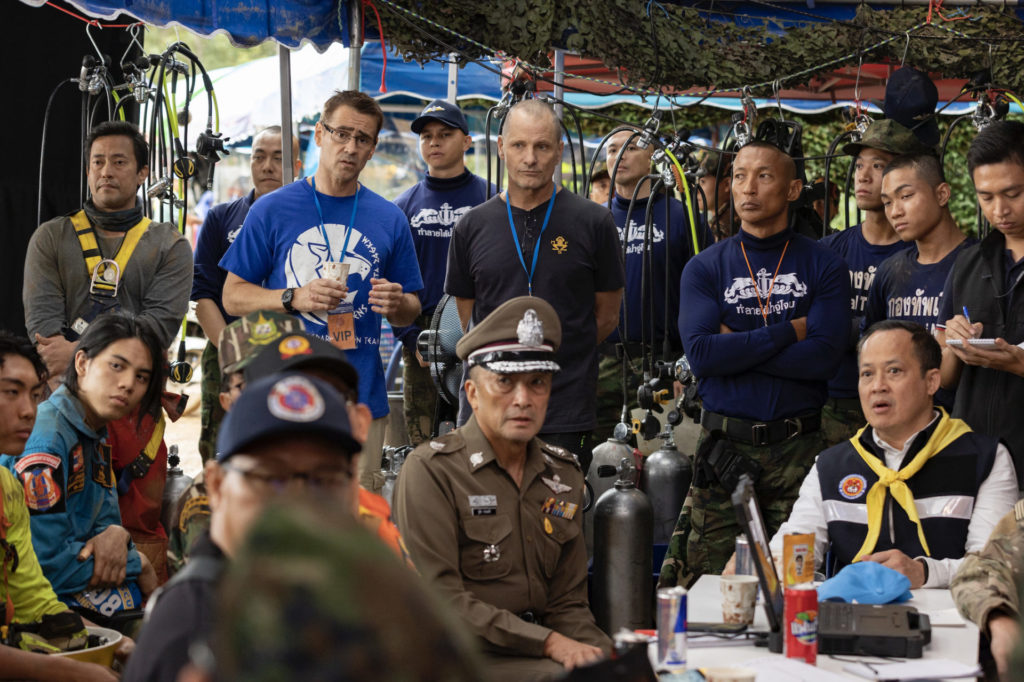
Q: Raymond, can you and the Thai cast members talk about the process of making this feel like a film made in Thailand with Thai people and about getting to work with Ron Howard on that.
Raymond: I was brought in for a couple of months during the scripting. One of the things that I really appreciated was how receptive Ron was in terms of ideas. He was really curious. That’s one of the things that I really liked about the way he works. He has an innate sense of curiosity to actually understand , “So how does this work?”
He’s always asking these kinds of questions. Sometimes, the answers were quite funny because they’re so specific. For example, when we were talking about the monk in the film, he said, “Oh, he has to be Burmese.” “Why?” I said. “Because they don’t shave off their eyebrows.” That’s just a tiny detail that makes it more authentic. We did our best to get across that we really did our research and Ron has been uber receptive about all of these minute details.
Our cast did their own research and did their own materials to really make them as real as possible. For example, Pattrakorn, not being a mother, did her own deep research on what it would be like if you were a [stateless] mother. We really had long conversations about all these things.
Q: How did you prepare for this role?
Ploy: I went back to watch the news, the documentary and the interviews with all the parents, the real parents. I focused on their real reactions. I focused on every detail, how they wear the clothes, how they talk, how they move. I focused on everything.
Ron: Also there’s spirituality. We will talk about that a little bit…
Ploy: When Ron asked me what stuff[struck me]I thought about the things that recall the mothers’ faces and I told him because in the northern part of Thailand, in Chiang Rai, we believe in the [Buddha and spirits] a lot.
If I give a gift to someone, this means I bless you and they’re safe and bring you luck. It’s very important in Thailand, and in Chiang Rai. I’m so happy that Ron and Raymond listened to my opinion.
Raymond: It became quite an important part of the film in the end.
Q: Weir, in portraying a story that you know well, what were some of the things that you brought to it that you thought were essential in telling it accurately?
Weir: I play the Saman role. Saman is the one the [casualty during the rescue]. I had a chance to talk to his family about who he was. I discussed directly with Ron about the script and the character of Saman. He gave me confidence and made me realize how much I’m capable of playing such a challenging role. Ron is very friendly to the team. Everyone made the film perfect.
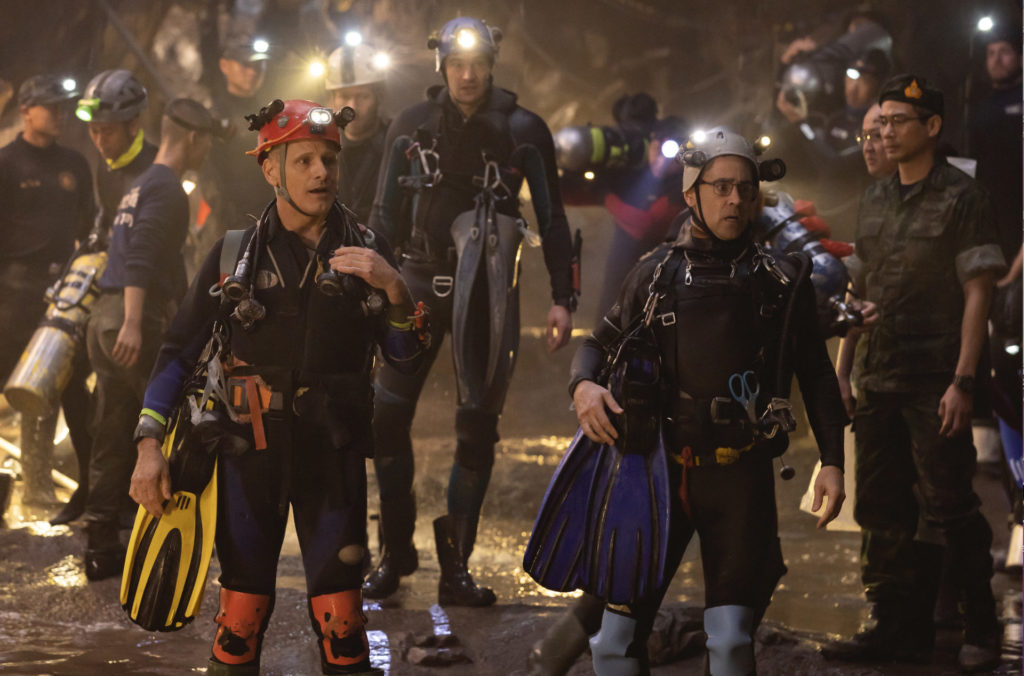
Q: Have Saman’s parents seen the film yet?
Ron: I don’t believe so. There are going to be screenings and it will be made available in about another week or so. But we’re not sure who’s invited and who’s not at this point.
Q: How did you feel about contributing to this film, and working with Ron Howard?
Weir: On the first day, the team told me that I got this role. I couldn’t believe it, — it’s just like this is a dream, having a chance to work with Ron Howard in a Hollywood film. It’s a big opportunity for me. I was very nervous at the time and I remember that, on the first day I met Ron, he was in the conversation and was busy so we didn’t have time to talk.
After that, Ron came and introduced himself properly to me. It should be me introducing myself to Ron, but he came to me and said, “Hi, I’m Ron, nice to meet you, you’re James, right?” Then he walked through the cave on the set that we built it up and he showed me everything, “You’re gonna sit here; the water will come from here. Then he showed me everything and then he told me that, “Okay, you can stay here for a while, if you want to feel something, if you want to meditate in here just take your time.” As for my first impression with Ron , I still remember that day. It’s a big opportunity for me. Thank you so much, Ron.
Ron: James [Teeradon] is a very popular performer and actor in his generation. A lot of the young actors weren’t actors, they were from the north primarily, and had not acted before. Our other producer Billy, a Thai producer, was working closely with them. But James was very important in actually leading them and guiding them and helping them understand how to be in a movie. So he was their coach on screen, but he was also very much their coach throughout the movie as well. And he brought so much to the film.
Weir: I think that we have like a rehearsal, a workshop, like a lot, me and the boys and Raymond. We have many rehearsals. We have the Zoom and we have to talk to each other, prepare and then read the script together. And then after the quarantine, we have like a 10-day rehearsal. I remember that I have to teach them how to meditate also because like all of the boys, I think not all of them can meditate, and they don’t know how to meditate. I went to the temple for [a few days?] and learnt how to meditate with a monk, and after that I taught the boy, okay, you have to meditate. Every time, before the rehearsal started, I’d lead them to meditate for like 10 minutes. After the rehearsal ended, another 10 minutes.
Q: How much time did you spend in that cave, you know, every day, were you there for hours and hours?
Ron: It was all the rehearsal time and 10 straight days of shooting right at the beginning of the film. There was a tremendous amount of pressure, on the boys and on James too and everyone to get those early scenes right.
Q: Does it get intense to be filming in a situation like that?
Weir: Yes, of course. In the cave, everything was like, very wet inside and then it’s very [intense]… I remember that in the scene when the diver came into the cave and found the boys and the coach — it’s the first day that we have in the shooting days so I was like, assuming the worst at that time. It was my first day here and all the sets make me feel like, “Oh, it’s quite hard actually!”

Q: There was so much water in this film, which of course is challenging for a filmmaker, or an actor, but not maybe for divers. You’ve seen this on the big screen now and the sound of those canisters and the bubbles and it was so intense, how accurate did that feel?
Rick: That was one of the things we were brought [into the film], Jason and myself, as technical advisors. We said early on that you get these sudden noises, moving cylinders, you get the big clang that makes everyone jump. That really happened on set and these have been brought out in sound engineering, that’s what it sounded like. When you’re underwater in caves like that, you can’t see very much. One of your primary senses is hearing and that’s heightened. You get bubbles drifting along the ceiling and making noises, the breath, everything’s accentuated because your eyesight is limited. That’s entirely real.
Q: Were you on set as they filmed these scenes as well?
Rick: Yeah, the whole time, the whole period in Australia, as a technical advisor.
Q: What was it like to see the actual recreations of what you experienced being filmed?
Rick: I’ve never worked on a film before, so the whole process of being involved in movie-making was incredible. It’s a story we were intimately involved with. I’m really proud of what we did in Thailand and I see it as a celebration. I’m proud to have helped other people see it by making this film as authentic as it could possibly be.
Q: Who knew that these teams of divers were the ones sent out on rescue missions? Can you tell us a little bit about this?
Rick: Clearly, there’s a backstory for this because if you think about it, it’s preposterous that myself, a 57-year-old man who lives in England, was flown into Thailand to take part in this rescue. If you think about that, that’s ludicrous. And watching the actors, who were age-appropriate, wandering around with all this equipment in the cave, it brought it home to me how preposterous we must have looked out there. But, there’s a huge back story to what John, Jason and myself have done, not just in rescues but — this is a hobby — we do this for a hobby. We got a name for doing our hobby and because of that, we were the people to call on various incidents and resolve them. We’ve been flown across Europe, we’ve been flown across the Atlantic to do things all over the world. So we have a huge back history and are largely successful with these sorts of rescues. That’s why we were called in.
But it’s entirely voluntary. We don’t have to do it, it’s not our job. Why would you? Because we have amassed those skills. So when I heard about the rescue in Thailand, it was entirely appropriate that we would go. We were amongst the best placed people on the planet to go there and make a difference.
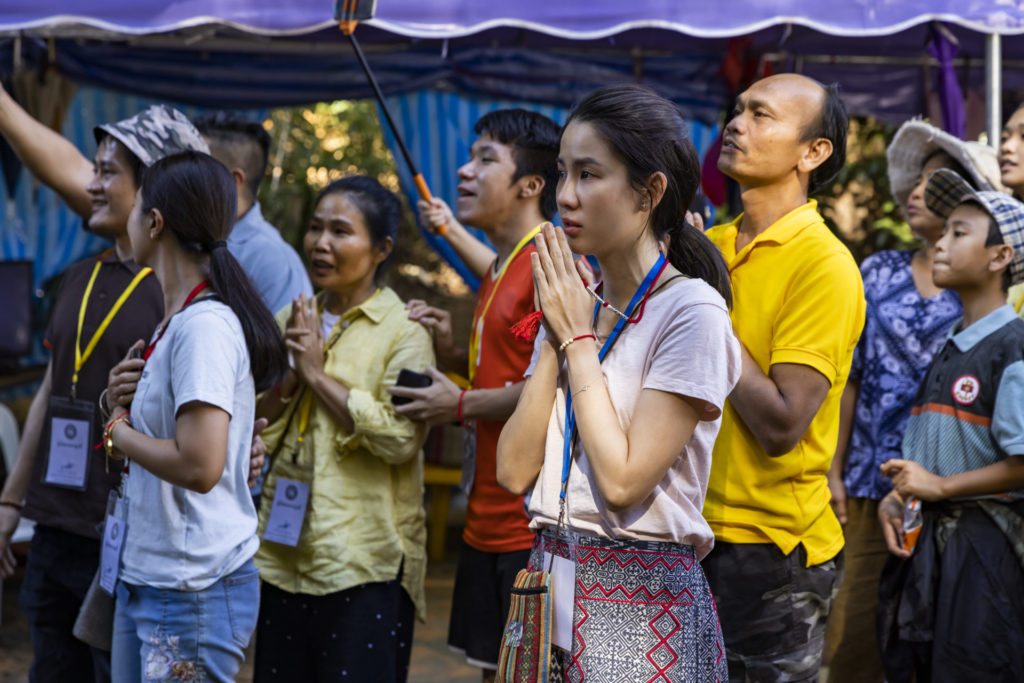
Credit: Vince Valitutti / Metro Goldwyn Mayer Pictures
© 2022 Metro-Goldwyn-Mayer Pictures Inc. All Rights Reserved.
Q: To our actors who portrayed the divers, let’s hear about that actual performance. Was it as terrifying to do takes again and again as it was to watch?
Viggo: We prepared. Fortunately Ron and his team gave us lots of time to prepare. I had also been speaking for months with Rick, it was during the pandemic, so it was mostly by Zoom although I did get to meet him in England at one point. I don’t know if we were following the rules exactly, I shouldn’t say that, but as far as meeting up, we found a way to meet up. It worked. we were safe. But he did turn me on to Tim and said, “I can’t bring you to England to a cave dive, but we could meet briefly because you have to go do some work in London and I’ll meet you.”
He turned me on to some people that he had trained with Jason and John in northern Spain in the mountains there. He said, “The rock is the same as in these caves in Thailand and the situation, the conditions are the same, the water’s a bit colder, it’s winter. But you could try that.” So I learned that a little bit and thought wow, this is harrowing, why would someone do this for fun? It’s crazy. But as an actor, you want to get it right. I was not only listening [clears throat] to Rick the way he spoke and trying to learn as much as I could, via Zoom he’d show me pictures, videos, so forth.
Then we went there and got prepared and all of us actors who are playing these divers, we just watched them very carefully. You want to get it right, but you also want to survive the shoot [laughs]. It’s like we were very, very attentive to everything they…
Q: So it was real. This wasn’t like a lot of special effects of bubbles and things. You all were really doing…
Viggo: Ron is a remarkable storyteller and the way he did this movie, it’s like a giant independent film. You talked about the subtitling, that there’s actually Thai actors speaking Thai.
If this was a movie that was made 20 or 30 years ago or by another kind of director, all the Thai characters would be speaking English and it would be mainly about the westerners and some heroic thing. This was not that. And it wasn’t a special effects movie. We were underwater, really doing these things. Once they realized we could do it, Rick said to Ron, “No, I think these guys have learned enough that they can really do this, you know, we’ll supervise all the time and be careful, but they can they safely do it,” which allowed Ron to see us up close under there. It’s not like they took our heads and put them on stunt men.
Ron: I have to jump in here to give you a sense of Viggo’s focus, Colin as well, and everyone, it wasn’t quite like that where I said, “Oh, I guess you guys could do all the diving. There was practically an intervention. Viggo came in and said, “This is so much a part of our character and now that we understand it and talk with Rick, but I think he’ll see that we can do it safely,” which Rick confirmed and so did our stunt coordinator, “Please schedule it so we do all the diving.” Well, that’s a totally preposterous idea for a production as complicated as this one. And we had money, but not that much money.
I said, “Viggo, come on, I appreciate what you’re saying, but I don’t know if I can do that.” And they literally said, “Whatever it takes for us, we will forget about our turnaround,” sorry, SAG, Screen Actors Guild. But, “We’ll go in on Saturdays,” and they did it. And they worked so hard because at that point, they said this is a part of our character and cave diving is so specific and we’ve learned and we’ve gotta do it. So that allowed me, the director, to create these kinds of long lingering shots that would resolve on their faces and you would recognize that in these tight spots, twisting, turning, moving their tanks, reaching up, pulling themselves along the rocks, that’s them. And they did it. They did every bit of it. Everybody did.
Q: Would you like to speak to the slipping and sliding?
Joel: It really was exciting and we were in a controlled environment, but at the same time with all the fast-tracked training and understanding the madness of underwater cave diving, of diving in zero visibility with all this extra equipment. Of course, in this case of the rescue, getting towards a point where we could carry stunt people and the kids unconscious, pretending to be unconscious, through these really difficult obstacles, we were in a safe environment, we were very well looked after and very well trained and guided.
But there were moments that really underlined for us how dangerous cave diving is, how dangerous it can be if you aren’t in the safe environment that we’re in. But it was fun because I can’t imagine where there’s another job that you get to go and live out what’s like a childhood fantasy which is like pretending to be a real life hero, which I’m not, [laughs] and learning a new skill and understanding something that you may not have investigated before.
Most movies give you that opportunity to learn something new about a culture and its history, about a skill that you may not have had at that time in your life and somebody gives you that opportunity, opens the door to that, and you take it. It’s fun and you make sure along the way [laughs] that you look after yourself.
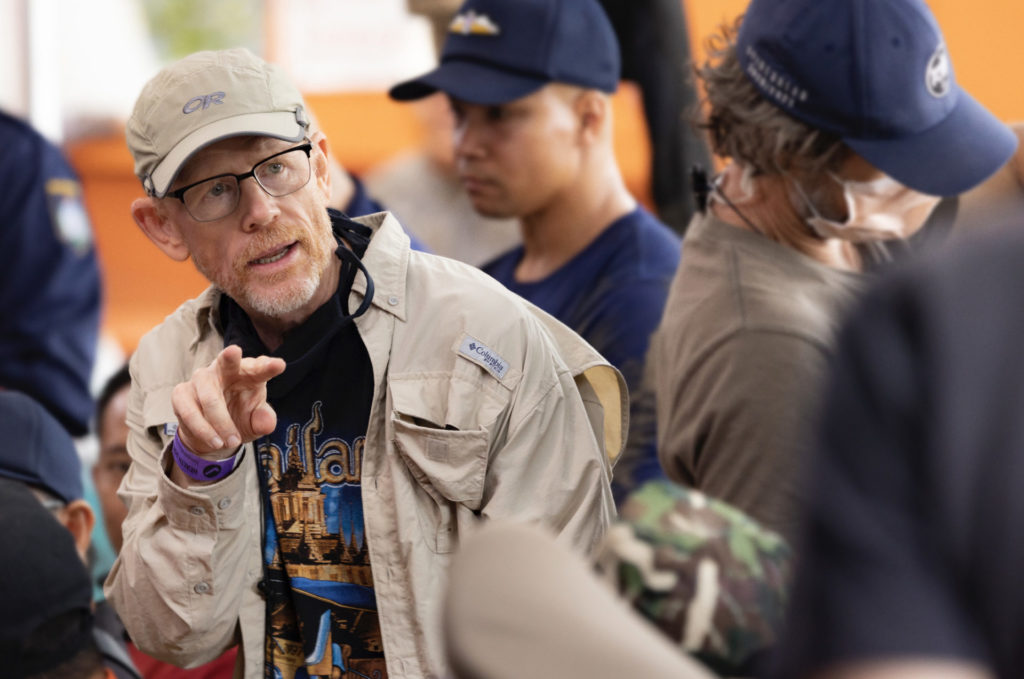
Q: We have an engineer here which is fun. Talk a little bit about water engineering and how we learned about this wonderful idea of yours.
Thanet: When I got the call from the Army asking me to go to the site where the rescue happens, I thought it was going to be a really simple mission. Just pump out the waters. As soon as I got there, the situation was totally different. It was really complicated. The hydrology of the mountain is a massive network of underground caves and waterways. In order to stop the water from going into the cave, we would have to divert a lot of water away from these, which involve a lot of labor, especially for the local villagers. The sacrifices of the farmers that let us flood their fields were incredible.]
As a collaboration with all the Thai people and the Royal Thai Army, a lot of engineers were at the scene at that point too. It was a big collaboration of all kinds of people. When we needed materials to divert the waters, we didn’t really go through official channels. We would just post it on social media. The next day, [people] would show up with sandbags, or show up with the material that we needed. That is a really touching story for me personally because it’s not just the two of us who actually did the rescue, but hundreds and thousands of Thai people and people around the world who supported us to make this rescue mission a success.
Q: What does this film bring to light about the event that no one has yet covered?
Ron Howard: Sahajak?
Q: Our governor.
Sahajak: I live in Thailand, so when this happened, I just knew that these kids were stuck in a cave and suddenly they were out. That’s what most of the people in the world today knew, just that much. But this film allows you to take it step by step and I believe this is what happened, even though I wasn’t there.
The gentlemen who were there are here to tell that story. Ron puts it in sequence so you understand how, when, where, and why the kids got in there, and how they came out. He shows how they spent their time there and who did what. Let me round this out by saying this is really the superhero movie of the year. It’s a super movie with many, many heroes, with Ron being the first superhero, Superman, to show what it was. I advise people to see this movie because it will give you an idea of what it is like if you get together to help one another, you make life much easier. There’s a lot of love in it.
Q: This film is epic in scale, but also is a story important to Thai people. What was the significance for you to be part of a film that portrays the world coming together for Thailand?
Raymond: I remember one of the first conversations I had with Ron when he said, “Look, we’re going through a pandemic, the world is not always the best place, but there’s a real opportunity here to make a film that show how wonderful it is that we can all come together and show that, regardless of nationalities and all these divisions that we have, that we can do something miraculous.” This film is a reminder of that. The fact is that it happened in Thailand and that we are all here in the end. Yes, it’s a Thai story and it happened in here, but I really want it to be considered as a human story, one that everybody can relate to regardless of divisions that we have.
We need this kind of film now to remind us of that. For me, and I hope, for the Thai actors who were a part of it, it really shows our culture and the things that we did to help make this miracle happen. I hope that everybody agrees with this when they watch it.
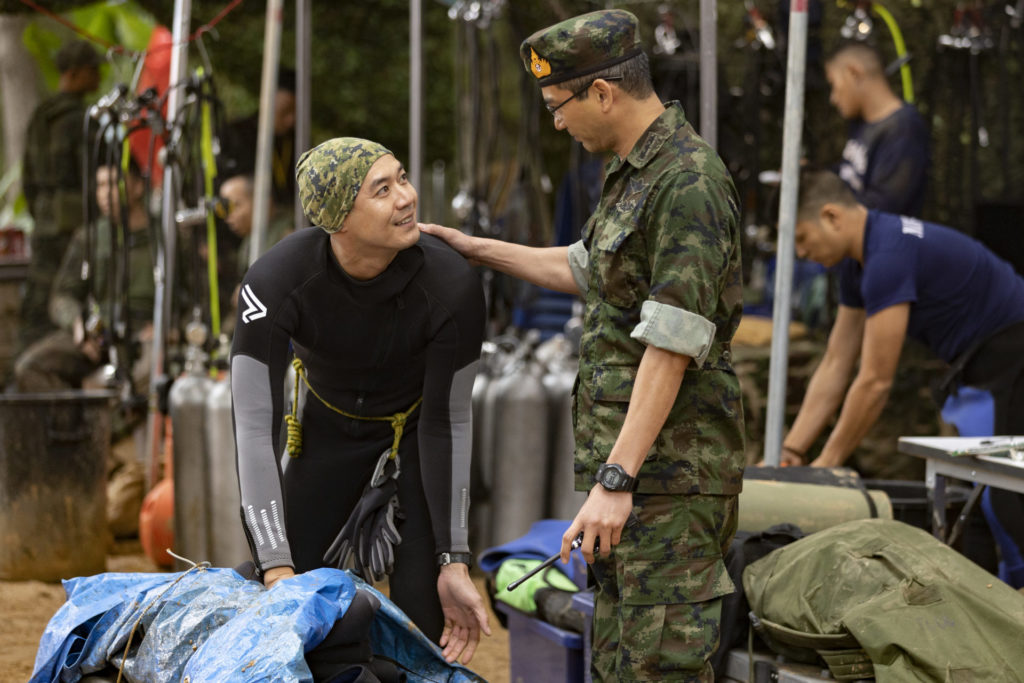
Credit: Vince Valitutti / Metro Goldwyn Mayer Pictures © 2022 Metro-Goldwyn-Mayer Pictures Inc. All Rights Reserved.
Q: This is for the actors. How did you train for these underwater sequences? What do you hope the audience will take away from it? Let’s start with Tom.
Tom: As Viggo said earlier, we had the most amazing team around us to help us look as good and authentic as possible. One of the things I found with this film was the lack of, for want of a better expression, “acting.” There wasn’t like [it was] a performance, there never was. I think when we were learning how to train, we just wanted to be as good as possible. That went down to the relationship that these guys have with their kit. Every morning, we would put our kit on, which would take a long time and you have to go through it religiously and that was the same underwater. You go through things step by step clinically. What was amazing in that thorough training was that it became part of your character without you having to present a character, You just did those things underwater. And we had two, maybe three weeks. But then I considered it a training the whole way through. Not until we wrapped, did I feel like, “Okay, that job is done.” Even on the last stunt day we were doing, I was still learning things, “Oh, this is a new pinch, this is a new direction we have to go in, I have to do something new to get my canister through here.” But we were in wonderful hands.
Q: So if I get trapped in a cave, one of you would be able to come rescue me?
Tom: We could [laughs].
Viggo: Between all of us together, we could.
Q: All right, everybody, you got your marching orders here.
Ron: And I think they’d probably have Rick’s phone number on speed-dial.
Viggo: Yeah, we do.
Q: He’s the one I would really want.
Tom: You’ll never believe who rescued me from that case.
Joel: Viggo Mortensen turned up.
Viggo: As far as the actors go, one thing that’s great about this movie is that everybody in it — just like in the real story that we’re referencing — is a supporting actor. There are no lead actors in this movie or in this story. And that was a beautiful thing.
Like Raymond, Ron and others were talking about, it’s great nowadays. With many of the so-called leaders in this country and in countries around the world, exhibit a kind of selfish, greedy, dishonest behavior as something to have as an example, it’s wonderful that you have a recent event that exemplifies selfless collaboration [clears throat] for the common good.
Neither Rick nor any of the others, none of the Thai people, were doing this because they were going to get rich, gain new territory, or political power. People did it because it was the right thing to do. And it does show — like Raymond was saying — the best of us, that humans are capable of doing amazing things together. We sometimes forget that and we even get fascinated by people who behave really badly and selfishly. It’s like “Wow, that’s cool, look at how they got that done, they’ve got power and maybe I should vote for that person.”
And it’s like, “No, maybe not.” Maybe these people — most of whom are pretty much if not all are — none of them were known or famous people. They got together and did something amazing for all the right reasons. And we can do that more than once.
Check out more of Nobuhiro’s articles.
Here’s the trailer of the film.

